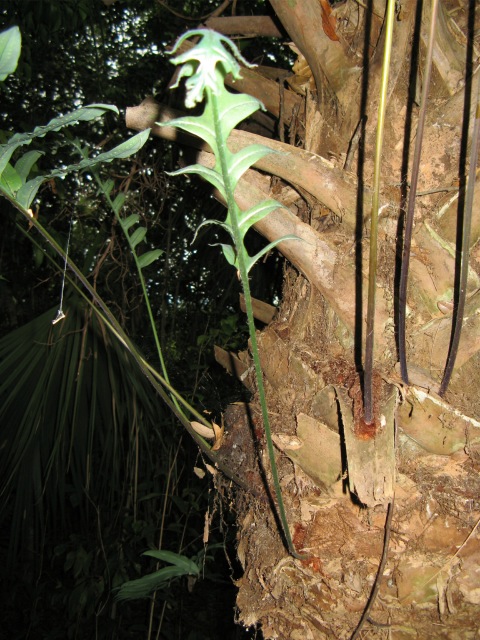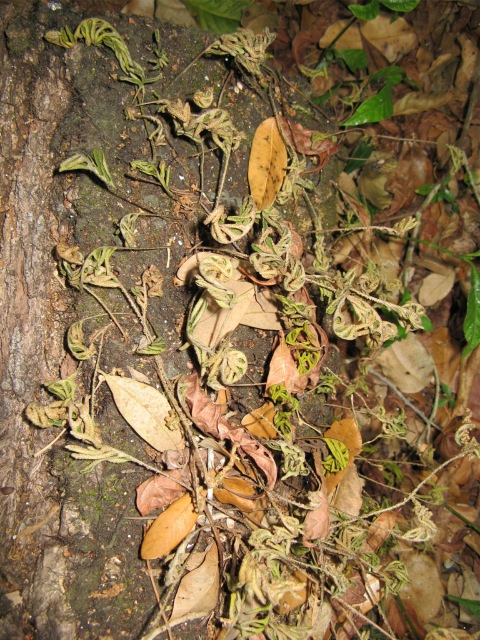Spring in South Florida
I’ve learned that folks who haven’t visited South Florida have the misconception that there is no winter here. While it doesn’t get cold by northern standards, the plants do slow down and many actually lose their leaves. Among native trees, the Gumbo-limbo (bursera simaruba) stands out in its nakedness during the winter months. It is a soft wooded tree that is a pioneer in hardwood hammocks and breaks very easily during hurricanes. Why this website says that it is “one of the most wind-tolerant trees in south Florida and is recommended as a good, hurricane-resistant species” is beyond me. I like to call it the “tourist tree” because it has red, peeling bark, similar to the skin of northerners after they bake in the sun for a few days on South Florida beaches!
One of a very few non-native trees that I have growing on my property is the Frangi-pani (Plumeria spp.):

Did I ever mention that yellow is my favorite color? You can see the broad dark green leaves behind the flower cluster – they drop off during the winter months and the shrub looks like a post-modern sculpture.
The Gold Foot Fern (phlebodium aureum), a native fern that I added to my property (a friend gave me two plants), is usually found growing in the boots of the native Cabbage Palm (sabal palmetto). In the winter, the fronds die and then, in the spring, new fronds sprout:

The word “boot” needs to be explained: they are the basal remnant of the frond after it either naturally breaks off after dying or after it is cut by a human. The boots form an interlocking protective shield that hosts a variety of life, carpenter ants, beetles, and other insects among them. If you visit South Florida and see the many cabbage palms on the sides of the roads, you will notice that they don’t have boots – that is because the landscapers remove them – they are considered “messy looking”, I suppose. The Gold Foot Fern is so called because the root is golden in color – you can see the roots at the base of the fronds in the picture.
Another native species of fern that never fails to fascinate visitors to South Florida is the Resurrection Fern (polypodium polypodioides). Here is a picture I took of one of the many ferns on my property last week, before the rains arrived:

All of those shriveled fronds spring to life when the summer rains arrive:

This is the very same plant – hard to believe that such a dramatic change could take place overnight, isn’t it? But this fern, which lives exclusively on the bark of trees (it doesn’t grow in the ground) has adapted to the dry winters in the tropics by shriveling up and conserving moisture until the rains arrive in the spring.
Spring is very subtle in South Florida – not at all dramatic like it is in northern climes. But we still have a distinctive change in the flora here at this time of year. If I can master close-up photography, I’ll share more fascinating pictures in the future.

I am sure I would be like one of the plants with red peeling bark if I visited Florida!
The frangipane is so exotic looking and beautiful! The resurrection fern is terrific. I love seeing how different environs support such different flora and fauna. Cool. In Texas, where I come from, spring is a bit more subtle as well. But beautiful.
Oh my goodness, Chris should lighten up. That was a nice response Jeff. I wish I was more like you. At the risk of making you think of politics again, that was very Obama-like, lol.
Yellow is my favorite color too! It doesn’t look good on me though. But I like to see it. It cheers me up. It’s sunny. My whole kitchen is yellow. Even my kitchen table.
http://www.GreenerPastures–ACityGirlGoesCountry.blogspot.com
Thanks so much, Jeff, for sharing these pictures of spring in South Florida. So interesting to know that you can see the changing of the seasons there, though it is more subtle. The flowers of the Frangi-pani tree are stunningly beautiful. Amazing, too, is the dramatic change in the Resurrection fern after rain. I would have guessed it to be dead in the “before” picture, so I can readily see how it got its name. I’d love to see more pictures of where you live in the future. A very nice post.
“I’ve learned that folks who don’t live in South Florida have the misconception that there is no winter here.” Would that be that ALL folks who don’t live in South Florida have misconceptions? How about the millions of us who have spent many winters there? Some of us are not ignorant or unobservant. Perhaps your education could use some revising.
Good point. I modified the post so that it reads “folks who haven’t visited South Florida”.